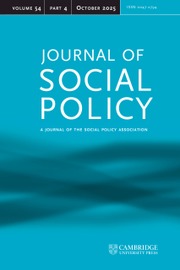Crossref Citations
This article has been cited by the following publications. This list is generated based on data provided by
Crossref.
PRATT, DAVID
SCHOFIELD, P. R.
HEALEY, JONATHAN
KIRBY, PETER
BRADLEY, KATE
TAYLOR, JAMES
and
BROWNLOW, GRAHAM
2010.
Review of periodical literature published in 2008.
The Economic History Review,
Vol. 63,
Issue. 1,
p.
187.
Mathew, Leemamol
2010.
Coping with Shame of Poverty.
Psychology and Developing Societies,
Vol. 22,
Issue. 2,
p.
385.
Nolan, Brian
and
Whelan, Christopher T.
2010.
Using non‐monetary deprivation indicators to analyze poverty and social exclusion: Lessons from Europe?.
Journal of Policy Analysis and Management,
Vol. 29,
Issue. 2,
p.
305.
Kehoe, Susan
and
O'Hare, Liam
2010.
The reliability and validity of the Family Affluence Scale.
Effective Education,
Vol. 2,
Issue. 2,
p.
155.
Palvarini, Pietro
2010.
Qualità abitativa e vivibilità urbana.
Quaderni di Sociologia,
p.
31.
Whelan, Christopher T.
and
Maître, Bertrand
2010.
Welfare regime and social class variation in poverty and economic vulnerability in Europe: an analysis of EU-SILC.
Journal of European Social Policy,
Vol. 20,
Issue. 4,
p.
316.
Bayram, Nuran
Aytac, Serpil
Aytac, Mustafa
Sam, Neslihan
and
Bilgel, Nazan
2012.
Poverty, Social Exclusion, and Life Satisfaction: A Study From Turkey.
Journal of Poverty,
Vol. 16,
Issue. 4,
p.
375.
Frenzel, Fabian
and
Koens, Ko
2012.
Slum Tourism: Developments in a Young Field of Interdisciplinary Tourism Research.
Tourism Geographies,
Vol. 14,
Issue. 2,
p.
195.
Pirani, Elena
2013.
Evaluating contemporary social exclusion in Europe: a hierarchical latent class approach.
Quality & Quantity,
Vol. 47,
Issue. 2,
p.
923.
Chase, Elaine
and
Walker, Robert
2013.
The Co-construction of Shame in the Context of Poverty: Beyond a Threat to the Social Bond.
Sociology,
Vol. 47,
Issue. 4,
p.
739.
Jo, Yongmie Nicola
2013.
Psycho-social dimensions of poverty: When poverty becomes shameful.
Critical Social Policy,
Vol. 33,
Issue. 3,
p.
514.
Saunders, Peter
Wong, Hung
and
Wong, Wo Ping
2014.
Signposting disadvantage – social exclusion in Hong Kong.
Journal of Asian Public Policy,
Vol. 7,
Issue. 1,
p.
3.
Frenzel, Fabian
2014.
Slum Tourism and Urban Regeneration: Touring Inner Johannesburg.
Urban Forum,
Vol. 25,
Issue. 4,
p.
431.
Okech, D.
Kim, J.
and
Little, T. D.
2015.
Recent Developments in Structural Equation Modelling Research in Social Work Journals.
British Journal of Social Work,
Vol. 45,
Issue. 2,
p.
685.
Edmiston, Daniel
2015.
Mixed Methods Research in Poverty and Vulnerability.
p.
33.
Pratschke, Jonathan
and
Haase, Trutz
2015.
A Longitudinal Study of Area-Level Deprivation in Ireland, 1991–2011.
Environment and Planning B: Planning and Design,
Vol. 42,
Issue. 3,
p.
384.
2015.
Vol. 2,
Issue. ,
p.
141.
Diris, Ron
and
Vandenbroucke, Frank
2016.
How Does Early Deprivation Relate to Later-Life Outcomes? A Longitudinal Analysis.
SSRN Electronic Journal ,
Terraneo, Marco
2016.
A longitudinal study of deprivation in European countries.
International Journal of Sociology and Social Policy,
Vol. 36,
Issue. 5/6,
p.
379.
Hick, Rod
2016.
Material poverty and multiple deprivation in Britain: the distinctiveness of multidimensional assessment.
Journal of Public Policy,
Vol. 36,
Issue. 2,
p.
277.

